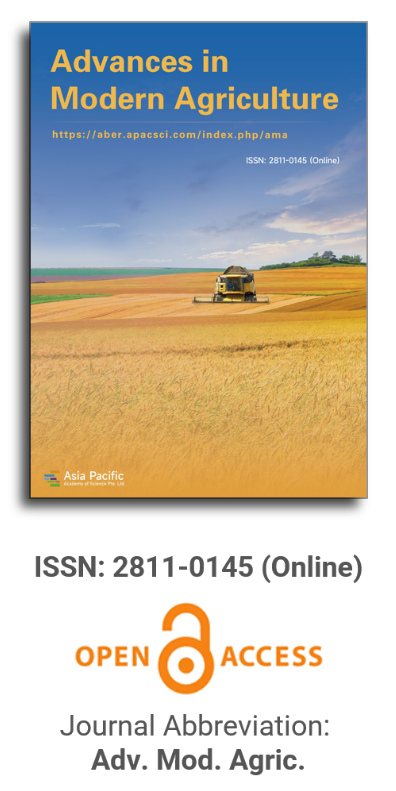


Climate variability and river flow changes in Wundanyi sub-catchment of Taita Hills, Kenya
Vol 5, Issue 1, 2024
VIEWS - 4258 (Abstract)
Download PDF
Abstract
Wundanyi sub-catchment of Taita hills is experiencing a high rate of deforestation due to the conversion of all its original forestland to agriculture and settlement during the last century. The landscape dynamics coupled with rainfall fluctuations in these critical ecosystems may significantly affect water resource distribution and food security in Taita Taveta County and its environs. This study aimed to establish the trends of selected hydroclimatic variables in Wundanyi sub-catchment from 1970 to 2030 and their specific and combined effects on surface runoff and streamflow in the same period. The analysis was based on statistical trend analysis and dynamic landscape modelling using both historical and primary hydroclimatic data from Wundanyi and Voi weather stations. Results show highly variable mean seasonal and annual values of temperature, rainfall, runoff and discharge in both Wundanyi and Voi weather stations. Increasing mean temperatures and rainfall were observed during the long dry season (JJAS), while decreasing seasonal discharges were observed during both the JJAS dry season and the OND short rainy season. These anomalies were pronounced in 1980–1981, 1986–1987 and 1992–1993, probably due to both global and local environmental changes affecting Taita Hills in general and Wundanyi sub-catchment in particular. The predicted effects of rainfall fluctuation were supported by declining surface runoff of 1.3% during JJAS, and an increase of 0.8% during the OND, with similar effects on river discharges. The combined effects of climate variability and Land use and cover changes (LUCC) on surface runoff were estimated to an increase of 200 mm during JJAS and 370 mm during OND, and while river discharges increased by 2.37 m3/s and 1.93 m3/s during JJAS and OND, respectively. Consequently, natural forest covers have significant control effects on surface runoff and can boost river discharges amid diverse agricultural cropping practices. Hence, crop diversification, agroforestry, and soil and water conservation structures are recommended to maintain effective control of LUCC on hydrological processes going on in Wundanyi sub-catchment.
Keywords
References
- IPCC. IPCC sixth assessment report: Africa. 2022. Available online: https://www.ipcc.ch/report/ar6/wg2/chapter/chapter-9/ (accessed on 11 October 2023).
- NOAA. Annual 2021 global climate report. Available online: https://www.ncei.noaa.gov/access/monitoring/monthly-report/global/202113 (accessed 11 October 2023).
- World Bank. Climate risk country profile: Kenya. 2021. Available online: https://climateknowledgeportal.worldbank.org/sites/default/files/2021-05/15724-WB_Kenya%20Country%20Profile-WEB.pdf (accessed on 11 October 2023).
- UN. Sustainable goals report 2022. Available online: https://unstats.un.org/sdgs/report/2022/The-Sustainable-Development-Goals-Report-2022.pdf (accessed on 11 October 2023).
- Luwesi CN, Shisanya CA, Obando JA. Climate change, excess land-uses and farmers’ water demand: An induction from smallholder farms in Muooni dam site, Kenya. Journal of Agri-Food and Applied Sciences. 2013; 1(2): 24-36.
- Wara C, Taye M, Quevauviller P, Willems P. Climate Change Impacts on the Water Cycle and River Flow Regime of Nyando River Catchment in Kenya [Master’s thesis]. Leuven: KU Leuven, Water Resources Engineering. 2015.
- Sood A, Muthuwatta L, Silva NS, et al. Understanding the Hydrological Impacts of Climate Change in the Tana River Basin, Kenya. International Water Management Institute (IWMI). 2017. doi: 10.5337/2017.220
- Kipchumba L, Cornu E. Climate change action in the water sector in Kenya: Status review. AECOM. 2021. Available online: https://publications.aecom.com/media/files/ClimateActionWaterSectorKenyaStatusReview.pdf (accessed on 11 October 2023).
- UNICEF. Impact report. 2017. Available online: https://www.unicef.org/kenya/media/471/file/Kenya-0000062.pdf (accessed on 11 October 2023).
- Bernoux M, Bockel L, Rioux J, et al. Carbon sequestration as an integral part of watershed management strategies to address climate change issues. Policy Brief. 2011. p. 4.
- WMO. State of the climate in Africa. 2020. Available online: https://library.wmo.int/doc_num.php?explnum_id=10929 (accessed on 11 October 2023).
- Ribeiro Neto A, da Paz AR, Marengo JA, et al. Hydrological Processes and Climate Change in Hydrographic Regions of Brazil. Journal of Water Resource and Protection. 2016; 8(12): 1103–1127. doi: 10.4236/jwarp.2016.812087
- Gentilucci M, Djouohou SI, Barbieri M, et al. Trend Analysis of Streamflows in Relation to Precipitation: A Case Study in Central Italy. Water. 2023; 15(8): 1586. doi: 10.3390/w15081586
- Ilbay-Yupa M, Ilbay F, Zubieta R, et al. Impacts of Climate Change on the Precipitation and Streamflow Regimes in Equatorial Regions: Guayas River Basin. Water. 2021; 13(21): 3138. doi: 10.3390/w13213138
- Chakravarty P, Kumar M. Floral Species in Pollution Remediation and Augmentation of Micrometeorological Conditions and Microclimate. Phytomanagement of Polluted Sites. Published online 2019: 203–219. doi: 10.1016/b978-0-12-813912-7.00006-5
- Konapala G, Mishra AK, Wada Y, et al. Climate change will affect global water availability through compounding changes in seasonal precipitation and evaporation. Nature Communications. 2020; 11(1). doi: 10.1038/s41467-020-16757-w
- Shah SA, Jehanzaib M, Lee JH, et al. Exploring the Factors Affecting Streamflow Conditions in the Han River Basin from a Regional Perspective. KSCE Journal of Civil Engineering. 2021; 25(12): 4931–4941. doi: 10.1007/s12205-021-0151-5
- Nyambariga FK, Opere AO, Kituyi E, et al. Climate change scenario projections and their implications on food systems in Taita Taveta County, Kenya. PLOS Climate. 2023; 2(6): e0000114. doi: 10.1371/journal.pclm.0000114
- Burgess ND, Butynski TM, Cordeiro NJ, et al. The biological importance of the Eastern Arc Mountains of Tanzania and Kenya. Biological Conservation. 2007; 134(2): 209–231. doi: 10.1016/j.biocon.2006.08.015.
- KTWA. Distribution of water towers in Kenya. Available online: https://watertowers.go.ke/water-towers/ (accessed on 11 October 2023).
- MoALF. Climate risk profile for Taita Taveta. Kenya county climate risk profile series. Nairobi: The Kenya Ministry of Agriculture, Livestock and Fisheries (MoALF). 2016.
- MoALF. Kenya county climate risk profile: Taita Taveta County. Nairobi: The Kenya Ministry of Agriculture, Livestock and Fisheries (MoALF). 2021.
- ICPAC. Report on historical climate baseline statistics for Taita Taveta, Kenya. Available online: https://www.icpac.net/documents/265/Kenya-Climate_baselines_Report_ACREI-Print_Copy_sVprJAj.pdf (accessed 11 October 2023).
- Hulme M, Doherty R, Ngara T, et al. African climate change: 1900–2100. Climate Research. 2001; 17: 145–168. doi: 10.3354/cr017145
- Rockström J. Managing rain for the future. In: Figueres CM, Tortajada C, Rockström J (editors). Rethinking water management-Innovative approaches to contemporary issues. London: Earthscan Publications Ltd; 2003. pp. 70–101.
- Bates BC, Kundzewicz ZW, Wu S, et al. Climate Change and Water. Technical Paper of the Intergovernmental Panel on Climate Change. Geneva: IPCC Secretariat; 2008. p. 210.
- Kundzewicz ZW, Mata LJ, Arnell NW, et al. Freshwater resources and their management. Climate Change 2007: Impacts, adaptation and vulnerability. In: Parry, ML, Canine OF, Palutikof JP, et al. (editors). Contribution of Working Group II to the Fourth assessment report of the Intergovernmental Panel on Climate Change. Cambridge: Cambridge University Press; 2007. pp. 173–210.
- Onyando JO. Rainfall-runoff models for ungauged catchments in Kenya. Herzogenrath: Shaker Verlag GmbH; 2000.
- UNEP. The fair share water strategy for sustainable development in Africa. Nairobi. UNEP. 1997. p. 20.
- Majaliwa JGM. Soil erosion from major agricultural land use types and associated pollution loading in the Selected Lake Victoria micro-catchments [PhD thesis]. Makerere University; 2005.
- Githui FW, Gitau W, Mutua FM, et al. Climate change impact on the variability of stream flow in western Kenya. International Journal of Climatology. 2007; 7(215).
- Luwesi C, Obando J, Shisanya C. The Impact of a Warming Micro‐Climate on Muooni Farmers of Kenya. Agriculture. 2017; 7(3): 20. doi: 10.3390/agriculture7030020
- Nearing MA, Jetten V, Baffaut C, et al. Modeling response of soil erosion and runoff to changes in precipitation and cover. CATENA. 2005; 61(2–3): 131–154. doi: 10.1016/j.catena.2005.03.007
- Luwesi CN, Obando JA, Shisanya CA. Hydro-geomorphologic impact assessment and economic viability of smallholder farms in Muooni catchment, Machakos District. Journal of Agri-Food and Applied Sciences. 2013; 1(1): 16–23.
Supporting Agencies
Copyright (c) 2024 Rose Adhiambo Akombo, Cush Ngonzo Luwesi, Joy Apiyo Obando
License URL: https://creativecommons.org/licenses/by/4.0/

This site is licensed under a Creative Commons Attribution 4.0 International License (CC BY 4.0).

Prof. Zhengjun Qiu
Zhejiang University, China

Cheng Sun
Academician of World Academy of Productivity Science; Executive Chairman, World Confederation of Productivity Science China Chapter, China
Indexing & Archiving
In the realm of modern agriculture, the integration of cutting-edge technologies is revolutionizing the way we approach sustainable farming practices. A recent study published in Advances in Modern Agriculture titled "Classification of cotton water stress using convolutional neural networks and UAV-based RGB imagery" has garnered significant attention for its innovative approach to precision irrigation management. Conducted by researchers from Institute of Data Science and the AgriLife Research and Extension Center of Texas A&M University (authors's information is below). This study introduces a novel method for classifying cotton water stress using unmanned aerial vehicles (UAVs) and convolutional neural networks (CNNs), offering a powerful solution for optimizing water use in agriculture.
Modern agricultural technology is evolving rapidly, with scientists collaborating with leading agricultural enterprises to develop intelligent management practices. These practices utilize advanced systems that provide tailored fertilization and treatment options for large-scale land management.
This journal values human initiative and intelligence, and the employment of AI technologies to write papers that replace the human mind is expressly prohibited. When there is a suspicious submission that uses AI tools to quickly piece together and generate research results, the editorial board of the journal will reject the article, and all journals under the publisher's umbrella will prohibit all authors from submitting their articles.
Readers and authors are asked to exercise caution and strictly adhere to the journal's policy regarding the usage of Artificial Intelligence Generated Content (AIGC) tools.
Asia Pacific Academy of Science Pte. Ltd. (APACSCI) specializes in international journal publishing. APACSCI adopts the open access publishing model and provides an important communication bridge for academic groups whose interest fields include engineering, technology, medicine, computer, mathematics, agriculture and forestry, and environment.



.jpg)
.jpg)

.jpg)
